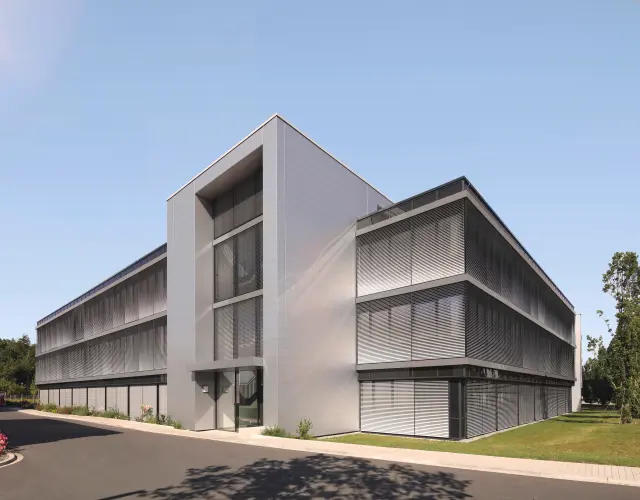
Most wanted: Summer protection against overheating Sun shading automation is the only way
As climate change progresses, people are increasingly focusing on protecting new and renovated buildings against overheating. Reducing the amount of heat entering through sunlight isn’t just a matter of user comfort: more than ever, this is essential to make buildings more resilient to the climate.
We’ve all heard the predictions: global warming is increasing and, as a result, summer protection against overheating is playing an ever greater role. Efficiently reducing the incidence of energy into buildings is taking on an ever more prominent role when planning new buildings and renovations. As the leading manufacturer of technical sun shading products, Warema believes it has a responsibility here, and supports the optimisation of building envelopes with its products and services.
Climate-active facades with automated sun shading
Automated sun shading means that the facade responds quickly to external conditions. This “climate-active facade” keeps out most of the solar energy in the summer. By lowering the amount of energy that enters, it prevents the building’s interior from overheating – and often removes the need to use energy-intensive technical cooling systems. Meanwhile, raising shading systems in the winter allows radiant energy to enter exactly where needed to help warm up the building. On winter nights, closing the sun shading can reduce energy loss through windows by up to 37% (additional thermal resistance of a roller shutter in combination with an existing window (Uw=2.7W/(m²K)). The incidence of daylight can also be optimised through automation, particularly with venetian blind products, meaning that less artificial light is required.
Focusing on the system concept
For Warema, the system concept is key when optimising building envelopes. The building components significant to energy transmittance – glazing and sun shading – are included in an overall energy value: the total solar energy transmittance (gtot).
Handing over to the “autopilot”
The gtot value is made up of the transmitted radiation and secondary ingress of heat from the absorbed radiation trapped between the sun shading and windows. The crucial factors for the sun shading are the reflection of long-wave, heat-intensive radiation and the least possible transmittance in combination with precise control of the daylight required. The good news is that users don’t need to worry about controlling the system. Automation can control the system much better and, most importantly, is proactive. The standard components required here are a weather station and a control unit with an intelligent algorithm that takes into account the position of the sun depending on the time of year, tracks the slats if required and controls the position of the sun shading based on the weather.
Studies show the potential of sun shading
RTG (Repräsentanz Transparente Gebäudehülle) is a Berlin-based advocacy group representing the glass, window, facade, automation, and sun shading industries, promoting climate-friendly, healthy, and affordable building solutions. It has commissioned several studies by the renowned engineering firm Ingenieurbüro Prof. Dr. Hauser (IBH) on the efficacy of sun shading. In its latest study, IBH 4 (based on a predefined generic test room with around 45 m² of floor space and a south-facing window area of around 36% of the room floor space), calculations show the great potential offered by external sun shading and an intelligent control system: if the external sun shading is operated conventionally, the number of hours with interior temperatures of over 26°C is reduced from 2,781 hours (without sun shading) to 512 hours. If the sun shading is activated at an early stage via automation, as with a climate-active facade, the number of hours can be reduced even further to 212. This equates to a value of just under 10% – compared with the situation without sun shading. If the interior is further cooled at night through ventilation, the number of hours with interior temperatures of over 26°C can be reduced to just 39, equivalent to less than 2%.
Logically, the best energy value is always achieved with the sun shading closed. However, the resulting lack of daylight would render these rooms largely useless without artificial light. But unused rooms are often the standard, rather than the exception. Precisely recording these times via presence detectors and information on weekends, public holidays, working times and vacations, and entering this data into the control system for the climate-active facade, is another potential way to save energy that often remains unexplored.
External venetian blinds combine heat protection and daylight incidence
Perfectly coordinating the amounts of daylight and shading is one of the key factors in effective summer heat protection. External venetian blinds offer the greatest benefits and flexibility here. Perfect slat angle tracking in accordance with the current elevation angle of the sun ensures that no direct solar radiation gets into the room – while maximising the incidence of diffuse daylight. Preventing the direct entry of solar radiation ensures there is no strong ingress of energy, while the controlled incidence of diffuse daylight allows energy to be saved by removing the need for artificial light.
What conclusions can we draw here?
The mere fact that around 40% of heat radiation can be reflected by slats is good news. However, we need to move away from the idea that “one size fits all” when drawing up plans. Every building needs to be considered individually. This goes for both renovations and new buildings, which is why Warema actively supports architects and specialised planners with this complex topic. The future of efficient heat protection lies in intelligent usage and ideal interplay between all home technology systems. And so for Warema, perfect sun shading systems combined with smart control solutions are more than a recommendation. These opportunities to optimise building envelopes need to be used, and they need to be used proactively.
Note on image usage:
The use of the unchanged images is only permitted in the context of the respective press release and exclusively for editorial reporting on WAREMA products, not for advertising purposes. Please use "Copyright WAREMA" as the correct acknowledgment of the source. Please send a digital specimen copy.
Downloads
Summer heat protection is currently designed based on a climatic map that uses data from 1988 to 2007.
Source: RTG/Daten: DWD/Warema
The forecast for the reference year 2045 clearly shows that in future, buildings will have to be designed to deal with warmer climatic conditions.
Source: RTG/Daten: DWD/Warema
The yearly proportion of hot days with outside temperatures of over 30°C is constantly increasing.
Source: RTG/Daten: DWD/Warema
Based on the forecasts for the reference year 2045, calculations show that buildings without sun shading will only be useable in the summer months with intensive cooling. In August, interior temperatures will be almost consistently above 30°C – day and night.
Source: RTG/ Ingenieurbüro Prof. Dr. Hauser (IBH)/Warema
With a climate-active facade with intelligent, proactive use of automated sun shading and additional night-time ventilation, the interior temperature will exceed 26°C on just a few days.
Source: RTG/ Ingenieurbüro Prof. Dr. Hauser (IBH)/Warema
Slats can already reflect around 40% of heat radiation. The gtot value is made up of the transmitted radiation and the secondary ingress of heat from the absorbed radiation trapped between the sun shading and windows.
Source: Warema
A weather station, such as the WAREMA Omnexo weather station pro, is an integral part of every climate-active facade.
Source: Warema
A “climate-active facade” wards off most of the solar energy in the summer – reduced energy incidence prevents the building’s interior from overheating.
Source: Warema
Slat tracking based on the position of the sun ensures that no direct solar radiation gets into the room – while maximising the incidence of diffuse daylight.
Source: Warema
The best energy value is achieved with closed sun shading in the summer. Rooms that aren’t being used can be programmed into the control system for the climate-active facade via presence detectors and information on weekends, public holidays, work days and vacations. This allows further energy to be saved.
Source: Warema
Opened external venetian blinds in the winter allow targeted entry of radiation energy to help heat rooms. If users experience glare, they can manually alter the position of the slats as required.
Source: Warema
Share this page:
Your direct contact to us







